白鳍豚英语作文
关于濒危动物白鳍豚的英语作文
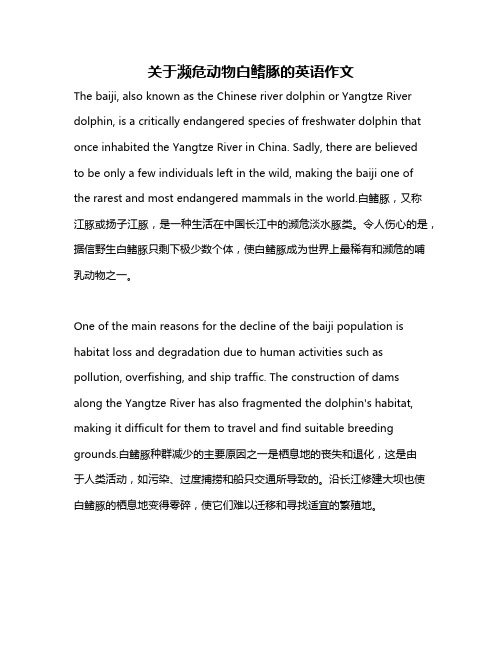
关于濒危动物白鳍豚的英语作文The baiji, also known as the Chinese river dolphin or Yangtze River dolphin, is a critically endangered species of freshwater dolphin that once inhabited the Yangtze River in China. Sadly, there are believedto be only a few individuals left in the wild, making the baiji one of the rarest and most endangered mammals in the world.白鳍豚,又称江豚或扬子江豚,是一种生活在中国长江中的濒危淡水豚类。
令人伤心的是,据信野生白鳍豚只剩下极少数个体,使白鳍豚成为世界上最稀有和濒危的哺乳动物之一。
One of the main reasons for the decline of the baiji population is habitat loss and degradation due to human activities such as pollution, overfishing, and ship traffic. The construction of dams along the Yangtze River has also fragmented the dolphin's habitat, making it difficult for them to travel and find suitable breeding grounds.白鳍豚种群减少的主要原因之一是栖息地的丧失和退化,这是由于人类活动,如污染、过度捕捞和船只交通所导致的。
介绍白鳍豚的英文作文
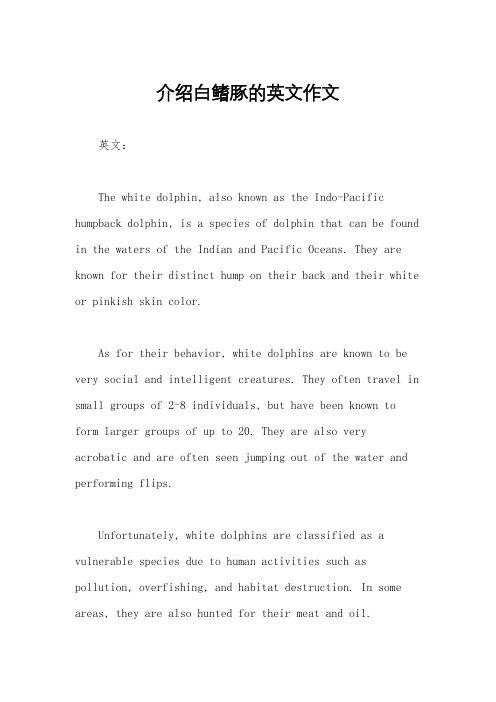
介绍白鳍豚的英文作文英文:The white dolphin, also known as the Indo-Pacific humpback dolphin, is a species of dolphin that can be found in the waters of the Indian and Pacific Oceans. They are known for their distinct hump on their back and their white or pinkish skin color.As for their behavior, white dolphins are known to be very social and intelligent creatures. They often travel in small groups of 2-8 individuals, but have been known to form larger groups of up to 20. They are also very acrobatic and are often seen jumping out of the water and performing flips.Unfortunately, white dolphins are classified as a vulnerable species due to human activities such as pollution, overfishing, and habitat destruction. In some areas, they are also hunted for their meat and oil.It is important for us to protect these beautiful creatures and their habitats. By reducing our impact on the environment and advocating for their conservation, we can help ensure that future generations can also enjoy the beauty of the white dolphin.中文:白鳍豚,又称印度-太平洋背鳍海豚,是一种生活在印度和太平洋海洋中的海豚。
白鳍豚的英语作文
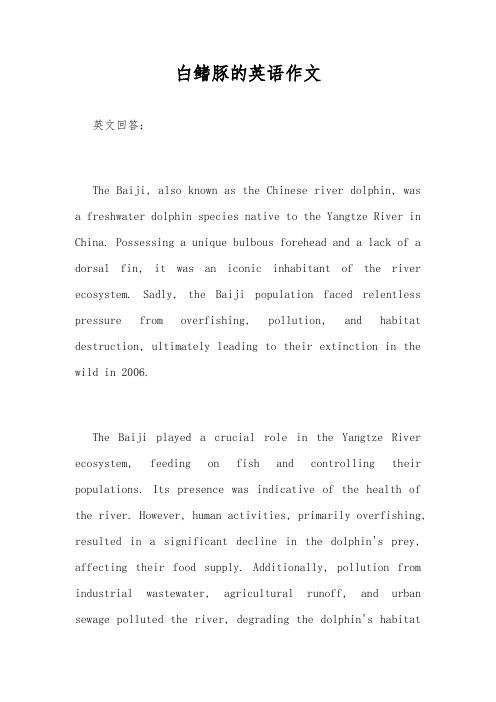
白鳍豚的英语作文英文回答:The Baiji, also known as the Chinese river dolphin, was a freshwater dolphin species native to the Yangtze River in China. Possessing a unique bulbous forehead and a lack of a dorsal fin, it was an iconic inhabitant of the river ecosystem. Sadly, the Baiji population faced relentless pressure from overfishing, pollution, and habitat destruction, ultimately leading to their extinction in the wild in 2006.The Baiji played a crucial role in the Yangtze River ecosystem, feeding on fish and controlling their populations. Its presence was indicative of the health of the river. However, human activities, primarily overfishing, resulted in a significant decline in the dolphin's prey, affecting their food supply. Additionally, pollution from industrial wastewater, agricultural runoff, and urban sewage polluted the river, degrading the dolphin's habitatand making it uninhabitable.Despite conservation efforts, such as protected areas and captive breeding programs, the Baiji population continued to dwindle. The last confirmed sighting of a wild Baiji was in 2004, and despite several expeditions, there have been no further sightings since. The species has been declared functionally extinct, as the remaining individuals, if any, are believed to be too few to sustain a viable population.中文回答:白鳍豚,也被称为中华江豚,是一种原生于中国长江的淡水豚类。
白鳍豚介绍英文介绍作文
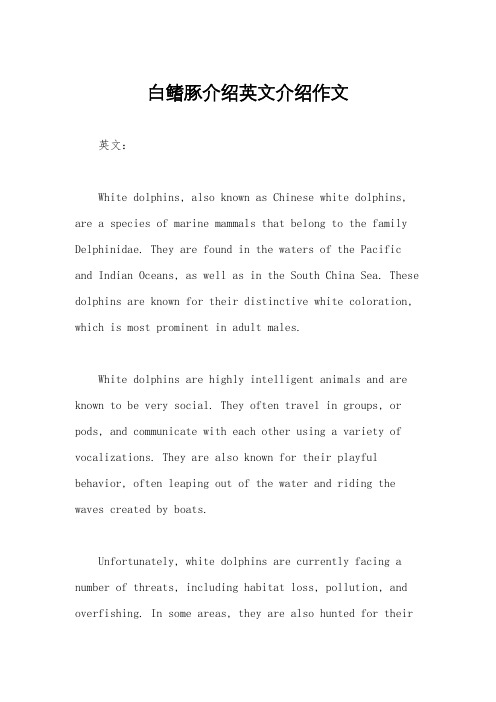
白鳍豚介绍英文介绍作文英文:White dolphins, also known as Chinese white dolphins, are a species of marine mammals that belong to the family Delphinidae. They are found in the waters of the Pacific and Indian Oceans, as well as in the South China Sea. These dolphins are known for their distinctive white coloration, which is most prominent in adult males.White dolphins are highly intelligent animals and are known to be very social. They often travel in groups, or pods, and communicate with each other using a variety of vocalizations. They are also known for their playful behavior, often leaping out of the water and riding the waves created by boats.Unfortunately, white dolphins are currently facing a number of threats, including habitat loss, pollution, and overfishing. In some areas, they are also hunted for theirmeat and oil. As a result, their populations have declined significantly in recent years, and they are now consideredto be a vulnerable species.中文:白鳍豚,也被称为中华白海豚,是属于海豚科的一种海洋哺乳动物。
白鳍豚濒危原因英文作文

白鳍豚濒危原因英文作文英文回答:The Baiji dolphin (Lipotes vexillifer), also known as the Chinese river dolphin, is an endangered species of freshwater dolphin found only in the Yangtze River in China. It is one of the most critically endangered cetaceans inthe world, with only a few individuals remaining in the wild. The primary causes of its decline are habitat loss, pollution, and overfishing.Habitat loss: The Yangtze River is one of the most heavily populated rivers in the world, and its banks have been extensively modified for human activities such as agriculture, industry, and transportation. This has led toa loss of the Baiji's natural habitat, which is essentialfor feeding, breeding, and socializing.Pollution: The Yangtze River is also heavily polluted, with high levels of industrial chemicals, agriculturalrunoff, and sewage. These pollutants can accumulate in the Baiji's body and cause a variety of health problems, including reproductive impairments, immune system suppression, and cancer.Overfishing: The Baiji dolphin is a top predator in the Yangtze River ecosystem, and its decline has had a cascading effect on other species. The loss of the Baiji has allowed populations of fish to increase, which has led to overfishing and a decline in the availability of preyfor the dolphin.In addition to these primary causes, other factors such as climate change and noise pollution are also believed to be contributing to the Baiji's decline. The combinedeffects of these stressors have made it difficult for the Baiji to survive and reproduce in the wild.中文回答:白鳍豚(学名,Lipotes vexillifer)又称中华江豚,是一种仅分布于中国长江流域的淡水鲸豚。
关于濒危动物白鳍豚的英语作文
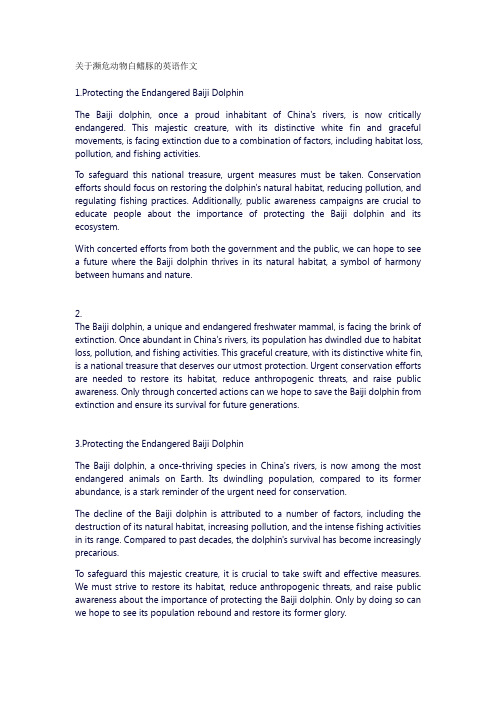
关于濒危动物白鳍豚的英语作文1.Protecting the Endangered Baiji DolphinThe Baiji dolphin, once a proud inhabitant of China's rivers, is now critically endangered. This majestic creature, with its distinctive white fin and graceful movements, is facing extinction due to a combination of factors, including habitat loss, pollution, and fishing activities.To safeguard this national treasure, urgent measures must be taken. Conservation efforts should focus on restoring the dolphin's natural habitat, reducing pollution, and regulating fishing practices. Additionally, public awareness campaigns are crucial to educate people about the importance of protecting the Baiji dolphin and its ecosystem.With concerted efforts from both the government and the public, we can hope to see a future where the Baiji dolphin thrives in its natural habitat, a symbol of harmony between humans and nature.2.The Baiji dolphin, a unique and endangered freshwater mammal, is facing the brink of extinction. Once abundant in China's rivers, its population has dwindled due to habitat loss, pollution, and fishing activities. This graceful creature, with its distinctive white fin, is a national treasure that deserves our utmost protection. Urgent conservation efforts are needed to restore its habitat, reduce anthropogenic threats, and raise public awareness. Only through concerted actions can we hope to save the Baiji dolphin from extinction and ensure its survival for future generations.3.Protecting the Endangered Baiji DolphinThe Baiji dolphin, a once-thriving species in China's rivers, is now among the most endangered animals on Earth. Its dwindling population, compared to its former abundance, is a stark reminder of the urgent need for conservation.The decline of the Baiji dolphin is attributed to a number of factors, including the destruction of its natural habitat, increasing pollution, and the intense fishing activities in its range. Compared to past decades, the dolphin's survival has become increasingly precarious.To safeguard this majestic creature, it is crucial to take swift and effective measures. We must strive to restore its habitat, reduce anthropogenic threats, and raise public awareness about the importance of protecting the Baiji dolphin. Only by doing so can we hope to see its population rebound and restore its former glory.In conclusion, protecting the endangered Baiji dolphin is not only a moral obligation but also a crucial step towards preserving our planet's biodiversity. Let us join forces to ensure a future where this majestic creature thrives once again.。
白鳍豚和如何保护白鳍豚的英语作文
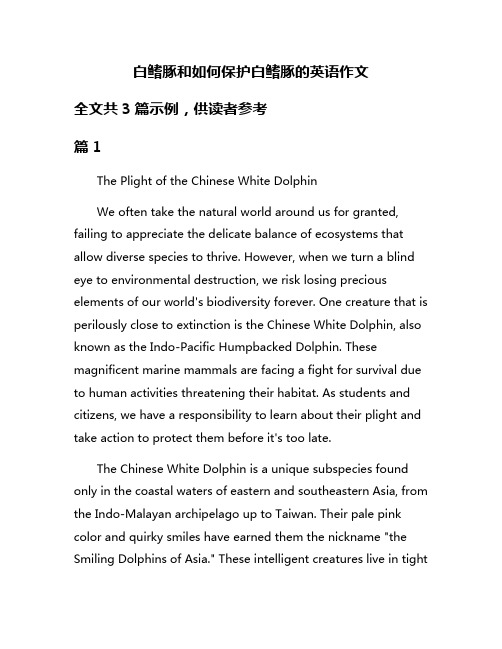
白鳍豚和如何保护白鳍豚的英语作文全文共3篇示例,供读者参考篇1The Plight of the Chinese White DolphinWe often take the natural world around us for granted, failing to appreciate the delicate balance of ecosystems that allow diverse species to thrive. However, when we turn a blind eye to environmental destruction, we risk losing precious elements of our world's biodiversity forever. One creature that is perilously close to extinction is the Chinese White Dolphin, also known as the Indo-Pacific Humpbacked Dolphin. These magnificent marine mammals are facing a fight for survival due to human activities threatening their habitat. As students and citizens, we have a responsibility to learn about their plight and take action to protect them before it's too late.The Chinese White Dolphin is a unique subspecies found only in the coastal waters of eastern and southeastern Asia, from the Indo-Malayan archipelago up to Taiwan. Their pale pink color and quirky smiles have earned them the nickname "the Smiling Dolphins of Asia." These intelligent creatures live in tightsocial groups and communicate through a wide range of whistles and clicks. Tragically, their numbers have plummeted in recent decades due to environmental degradation, pollution, and human encroachment on their natural habitats.One of the biggest threats to the Chinese White Dolphin is the destruction of their environment in the Pearl River Estuary near Hong Kong. This area serves as an important habitat for breeding and feeding for one of the largest remaining populations. However, large-scale coastal development projects like land reclamation and dredging have severely impacted the health of this ecosystem. The loud underwater noises from construction, increased boat traffic, and pollution being pumped into the waters are driving these sensitive creatures away. Their numbers in the Pearl River Estuary have dropped by a staggering 60% over the past 15 years.Additionally, the dolphins face threats from accidental capture in fishing gear, contamination of their food sources by industrial chemicals and plastics, and the effects of climate change disrupting marine environments. With their slow reproductive rates, even modest losses can be devastating for overall population recovery. Experts estimate that only a few thousand Chinese White Dolphins remain across their entirerange, down from tens of thousands just a century ago. Unless drastic conservation measures are immediately taken, we risk witnessing the extinction of these extraordinary creatures right before our eyes.So why should we care about saving the Chinese White Dolphin? Beyond being one of nature's precious treasures that we simply don't have the right to destroy, their existence is deeply intertwined with the health of entire marine ecosystems. As top predators, dolphins play a vital role in maintaining the delicate balance of food webs in coastal waters. Losing them could trigger catastrophic ripple effects on other species and disrupt the provision of environmental services like nutrient cycling that fuel productive fisheries and other economic activities. Safeguarding the Chinese White Dolphin's future preserves the biological richness of our oceans for generations to come.On a deeper level, these dolphins have tremendous cultural and intrinsic value, representing the beauty and mystery of the natural world. Their image has become an iconic symbol in the region, immortalized in ancient folklore and modern pop culture from Hong Kong's Cantopop music to the beloved mascot for the territory's annual Dragon Boat Festival races. To allow such aunique, intelligent, charismatic species to disappear from our world would be a profound moral failing and loss for humanity.The good news is that it's not too late to save the Chinese White Dolphin from extinction if we act swiftly and decisively. A number of local conservation groups have been working tirelessly on public awareness campaigns, monitoring population numbers, establishing protected marine reserves, and lobbying governments to enforce environmental regulations. However, they urgently need more public support and participation in order to succeed.As students, we have an opportunity to make our voices heard and actively engage in this important cause. We can start by educating ourselves and others about the threats facing these dolphins and the importance of protecting them. Organizing awareness events on campus, writing letters to elected officials, and using social media to rally support can help elevate this issue. Even seemingly small actions like reducing our personal plastic consumption and carbon footprints can have a positive ripple effect.Furthermore, we can volunteer our time and talents to aid the on-the-ground conservation efforts. Many organizations would surely appreciate help with data collection, fundraisinginitiatives, community outreach programs, and other crucial activities. Those with a passion for the sciences could even pursue research opportunities to study dolphin ecology and develop strategies for safeguarding their habitats. And for those interested in law or public policy, there's a critical need for legal advocacy to ensure existing environmental protection laws are properly enforced and strengthened.Ultimately, saving the Chinese White Dolphin requires a holistic, multi-pronged approach of environmental activism, responsible eco-tourism practices, corporate sustainability initiatives, and legislative actions to tackle pollution and overdevelopment systematically. Only by all stakeholders working collaboratively can we secure a future for this remarkable species. Although the path ahead remains dauntingly challenging, we simply cannot afford the alternative of resignating ourselves to yet another devastating extinction event.As the heirs to this planet, we have an obligation to be responsible stewards and protectors of the incredible biodiversity and natural wonders still remaining. The Chinese White Dolphin represents the opportunity to right our past wrongs and build a more sustainable, harmonious relationshipwith the natural world around us. We cannot fritter away that chance. Their smiles should be reminders to us of the inherent joy, peace, and wisdom represented by nature, inspiring us to do everything within our power to ensure their survival for generations to come. Let's make this our rallying cry and legacy as students and citizens: to fiercely protect the "Smiling Dolphins of Asia" and all they represent for the sake of our shared planet.篇2The Plight of the Chinese White Dolphin and Why We Must ActAs students, we are often taught about the wonders of the natural world and the importance of conservation. However, few examples hit as close to home as the Chinese white dolphin, a remarkable marine mammal found only in the waters around Hong Kong and the Pearl River estuary. With its distinctive pink color and friendly demeanor, this incredible creature has captured the hearts of locals and visitors alike. Yet, tragically, the future of the Chinese white dolphin hangs in a precarious balance, teetering on the edge of extinction. It is our responsibility, as the next generation of environmental stewards, to take action and ensure the survival of this remarkable species.The Chinese white dolphin, scientifically known as Sousa chinensis, is a true marvel of evolution. These intelligent and social creatures have adapted to the unique environment of the Pearl River estuary, thriving in its brackish waters and feeding on a variety of fish and crustaceans. Their striking pink hue, caused by blood vessels near the surface of their skin, has earned them the affectionate nickname "pink dolphins." Despite their gentle nature and iconic status, the Chinese white dolphin population has plummeted in recent decades, with estimates suggesting fewer than 2,000 individuals remaining in the wild.The threats facing this remarkable species are multifaceted and stem largely from human activities. Habitat loss and degradation, resulting from coastal development, dredging, and pollution, have severely impacted the dolphins' natural environment. The construction of the Hong Kong-Zhuhai-Macau Bridge, for instance, has fragmented their habitat and disrupted their migratory patterns. Additionally, noise pollution from heavy marine traffic and construction can interfere with the dolphins' ability to navigate, communicate, and hunt effectively.Overfishing and bycatch, the unintentional capture ofnon-target species, have also taken a significant toll on the Chinese white dolphin population. As their primary food sourcesare depleted, these dolphins struggle to find sufficient sustenance, leading to malnutrition and reduced reproductive success. Furthermore, the accumulation of pollutants, such as heavy metals and persistent organic pollutants, in the waters they inhabit poses a severe threat to their health and well-being.Faced with these daunting challenges, it is imperative that we, as students and future leaders, take action to protect the Chinese white dolphin. Inaction is simply not an option, as the loss of this remarkable species would be a devastating blow to the biodiversity and ecological balance of the Pearl River estuary.One of the most crucial steps we can take is to raise awareness about the plight of the Chinese white dolphin and the importance of its conservation. Through educational campaigns, social media outreach, and community events, we can inform the public about the threats facing this species and the urgency of the situation. By fostering a deeper understanding and appreciation for these magnificent creatures, we can garner greater support for conservation efforts and inspire individuals to make more environmentally conscious choices.Furthermore, we must advocate for stronger environmental regulations and enforcement measures to protect the Chinese white dolphin's habitat. This includes pushing for strictercontrols on coastal development, dredging, and pollution, as well as the establishment of marine protected areas and sanctuaries. By safeguarding their natural environment, we can ensure that the dolphins have the space and resources they need to thrive.Additionally, we should support and promote sustainable fishing practices that minimize bycatch and protect the dolphins' food sources. This may involve collaborating with local fishing communities, implementing bycatch reduction technologies, and exploring alternative livelihood opportunities that reduce the pressure on marine resources.Moreover, we must actively participate in scientific research and monitoring efforts to gain a deeper understanding of the Chinese white dolphin's ecology, behavior, and population dynamics. By contributing to citizen science projects and supporting scientific expeditions, we can provide valuable data and insights that inform conservation strategies and policymaking.Lastly, we should lead by example and adopt environmentally conscious lifestyles. This includes reducing our individual carbon footprints, minimizing our use of single-useplastics, and supporting businesses and organizations that prioritize sustainability and environmental protection.The Chinese white dolphin is not merely a remarkable species; it is a symbol of the resilience and beauty of nature, a reminder of the delicate balance that exists within our ecosystems. By taking action to protect this iconic creature, we are not only safeguarding its future but also preserving the rich biodiversity and cultural heritage of the Pearl River estuary region.As students, we have a unique opportunity to shape the future and leave a lasting legacy of environmental stewardship. Let us embrace this responsibility with passion and conviction, and together, we can ensure that the Chinese white dolphin continues to grace our waters for generations to come.篇3The Plight of the Chinese White DolphinI still vividly remember the first time I saw a Chinese white dolphin in the wild. It was a blazing hot day, and my family had taken a boat tour through the waters near Hong Kong. As our boat cut through the waves, I spotted a flash of pink in the distance. At first, I thought my eyes were playing tricks on me –there's no way I had just seen a pink dolphin! But as we drew closer, I could make out the distinctive pale pink coloring and stocky body of the rare Chinese white dolphin.Our tour guide explained that despite their name, these dolphins aren't actually white at all. Their pinkish hue comes from blood vessels showing through their pale gray skin. As I watched the pod swimming and leaping alongside our boat, I was mesmerized by their beauty and grace. Little did I know at the time, these amazing creatures are facing a fight for survival.The Chinese white dolphin, also known as the pink dolphin, is found only in the waters near Hong Kong and the Pearl River Estuary. Their numbers have declined dramatically in recent decades due to environmental pollution, boat traffic, underwater noise, loss of habitat, and overfishing depleting their food sources. It's estimated there are only around 2,000 individuals remaining in the wild.As top predators, these dolphins play a vital role in maintaining the health of their marine ecosystem. Their survival is intricately tied to the survival of the entire ecosystem they inhabit. A world without the Chinese white dolphin would be a much poorer place for all of us.After that first dolphin sighting, I became fascinated by them.I read every book and article I could find, determined to learn as much as possible about this incredible species. With each new fact I uncovered, my drive to help protect them grew stronger.One of the biggest threats facing the dolphins is water pollution. Hong Kong and the cities surrounding the Pearl River are among the most densely populated and industrial areas on Earth. Millions of tons of agricultural runoff, sewage, plastics, and industrial waste are dumped directly into the waters every year. This noxious pollution is poisoning the dolphins' habitat and food supply.Noise pollution from heavy ship traffic and coastal construction also disrupts the dolphins' sonar, which they use to navigate, find food, and communicate. Underwater noise can cause deafness, developmental deficits in calves, beach strandings, and even death.Overfishing of the prawns, fish, and squid that make up the dolphins' diet has severely depleted their food sources. They often have to compete with hungry humans for the same limited resources.Perhaps most tragically, many dolphins are injured or killed each year after colliding with high-speed ferries, cargo ships, andother vessels. With so many boats constantly crisscrossing their territory, the dolphins have little room to swim safely.Losing these dolphins would be an ecological catastrophe. But beyond that, it would deprive the world of one of its most magical and irreplaceable natural treasures. We have to act now to protect them before it's too late.So what can be done? Addressing water pollution has to be the top priority. Stricter regulations need to be put in place to stop industries, farms, and municipalities from using our ocean waters as a waste dump. Properly treating sewage and runoff before releasing it into the ocean would go a long way.Banning destructive fishing practices like bottom trawling would help restore depleted fish populations and protect the dolphins' food sources. Creating marine protected areas with designated "no-catch" zones would further aid this recovery.Speed limits and traffic rules for boats near dolphin habitats could reduce the number of deadly strikes each year. Ferries and shipping vessels could also be rerouted around the most critical dolphin areas.Above all, we need to raise public awareness of the Chinese white dolphin's plight. Only by building a groundswell ofconcern and activism can we push governments and corporations to take the difficult but necessary conservation actions.In my view, the loss of this extraordinary animal would be an ethical and ecological tragedy of unimaginable proportions. They are a living legacy that has survived on this planet for millions of years - we humans have simply been around for the blink of an eye in comparison. Do we have the right to drive them to extinction just because they're in our way?The Chinese white dolphin is a reminder of the beauty, diversity, and resilience of life on Earth. It represents everything pure, wild, and free in Nature. These dolphins have roamed the oceans for eons while our species was still just the dumbest of apes. Don't we owe it to them to let them swim on forever?Protecting the Chinese white dolphin won't just help that one species - it will mean preserving the entire integrated ecosystem that we all rely on. By saving the dolphins, we'll be saving marine habitats, fish populations, and ultimately, ourselves.So I'm pleading with anyone who will listen: care about the Chinese white dolphins. Read about their struggles, donate to conservation groups, contact your politicians, boycott pollutingcompanies, pick up trash from beaches. Do whatever you can to be part of the solution. Let's be the generation that didn't go extinct on the Chinese white dolphins. Let's ensure these incredible creatures will still be thrilling humans for generations to come.I want my children, grandchildren, and great-grandchildren to be able to experience the same sense of wonder and connection with nature that I felt on that first dolphin tour. But in order for that to happen, we need to step up and fight for the survival of this precious species before it disappears forever. The fate of the pink dolphin rests in our hands – let's not fail them.。
白鳍豚的英语作文
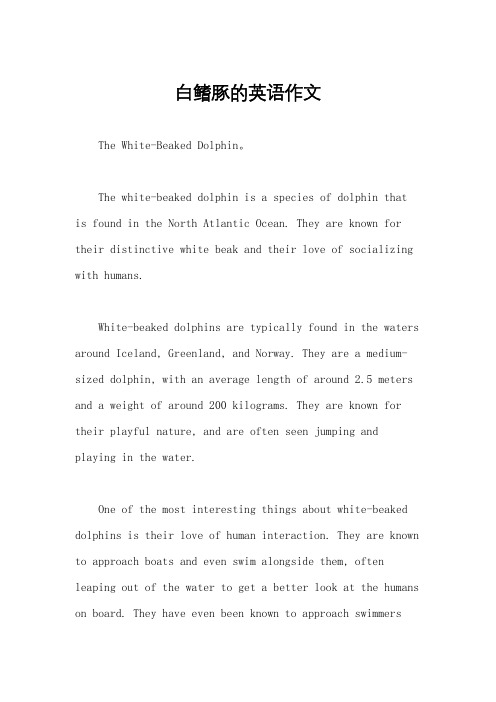
白鳍豚的英语作文The White-Beaked Dolphin。
The white-beaked dolphin is a species of dolphin thatis found in the North Atlantic Ocean. They are known for their distinctive white beak and their love of socializing with humans.White-beaked dolphins are typically found in the waters around Iceland, Greenland, and Norway. They are a medium-sized dolphin, with an average length of around 2.5 meters and a weight of around 200 kilograms. They are known for their playful nature, and are often seen jumping and playing in the water.One of the most interesting things about white-beaked dolphins is their love of human interaction. They are known to approach boats and even swim alongside them, often leaping out of the water to get a better look at the humans on board. They have even been known to approach swimmersand surfers, although this is rare.White-beaked dolphins are also known for their intelligence. They are highly social animals, and are often seen swimming in large groups. They communicate with each other using a complex system of clicks and whistles, and are able to work together to hunt for fish.Unfortunately, white-beaked dolphins are facing a number of threats in the wild. They are often caught accidentally in fishing nets, and are also affected by pollution and climate change. In some areas, they are hunted for their meat and blubber.To help protect white-beaked dolphins, it is important to reduce the amount of pollution in the oceans and to regulate fishing practices to minimize accidental catches. It is also important to educate people about the importance of protecting these amazing animals.In conclusion, the white-beaked dolphin is afascinating and intelligent animal that is loved by manypeople around the world. By working together to protect them, we can ensure that they continue to thrive in the wild for many years to come.。
关于白鳍豚的英文作文
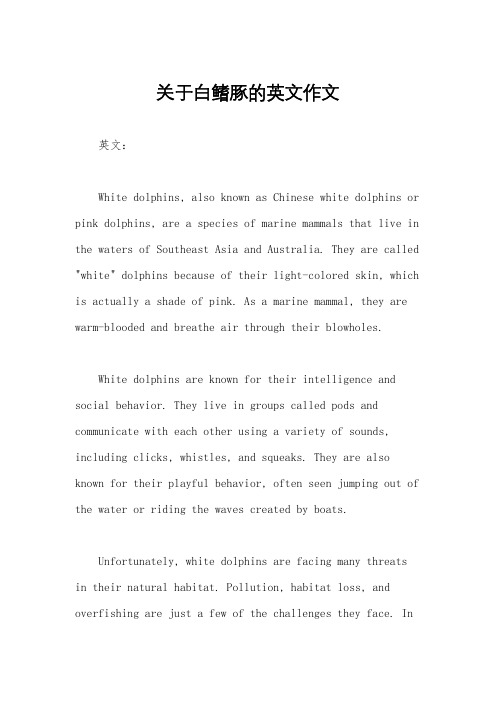
关于白鳍豚的英文作文英文:White dolphins, also known as Chinese white dolphins or pink dolphins, are a species of marine mammals that live in the waters of Southeast Asia and Australia. They are called "white" dolphins because of their light-colored skin, which is actually a shade of pink. As a marine mammal, they are warm-blooded and breathe air through their blowholes.White dolphins are known for their intelligence and social behavior. They live in groups called pods and communicate with each other using a variety of sounds, including clicks, whistles, and squeaks. They are also known for their playful behavior, often seen jumping out of the water or riding the waves created by boats.Unfortunately, white dolphins are facing many threatsin their natural habitat. Pollution, habitat loss, and overfishing are just a few of the challenges they face. Inaddition, they are often hunted for their meat and oil, which are used in traditional Chinese medicine.As humans, it is our responsibility to protect these amazing creatures and their habitat. We can do this by reducing our use of plastic and other pollutants,supporting conservation efforts, and advocating forstronger laws to protect marine life.中文:白鳍豚,又称为中华白海豚或粉色海豚,是一种生活在东南亚和澳大利亚水域的海洋哺乳动物。
关于保护白鳍豚的英语作文
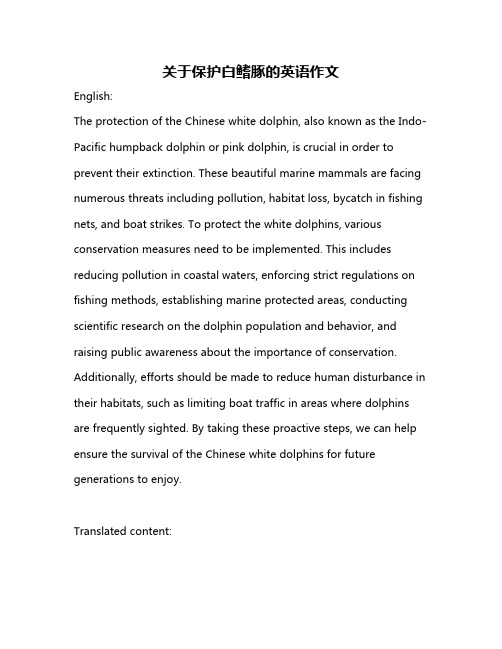
关于保护白鳍豚的英语作文English:The protection of the Chinese white dolphin, also known as the Indo-Pacific humpback dolphin or pink dolphin, is crucial in order to prevent their extinction. These beautiful marine mammals are facing numerous threats including pollution, habitat loss, bycatch in fishing nets, and boat strikes. To protect the white dolphins, various conservation measures need to be implemented. This includes reducing pollution in coastal waters, enforcing strict regulations on fishing methods, establishing marine protected areas, conducting scientific research on the dolphin population and behavior, and raising public awareness about the importance of conservation. Additionally, efforts should be made to reduce human disturbance in their habitats, such as limiting boat traffic in areas where dolphins are frequently sighted. By taking these proactive steps, we can help ensure the survival of the Chinese white dolphins for future generations to enjoy.Translated content:保护白鳍豚,也称为印度太平洋座头鲸或粉红海豚,对于防止它们灭绝至关重要。
关于保护白鳍豚的英语作文高一
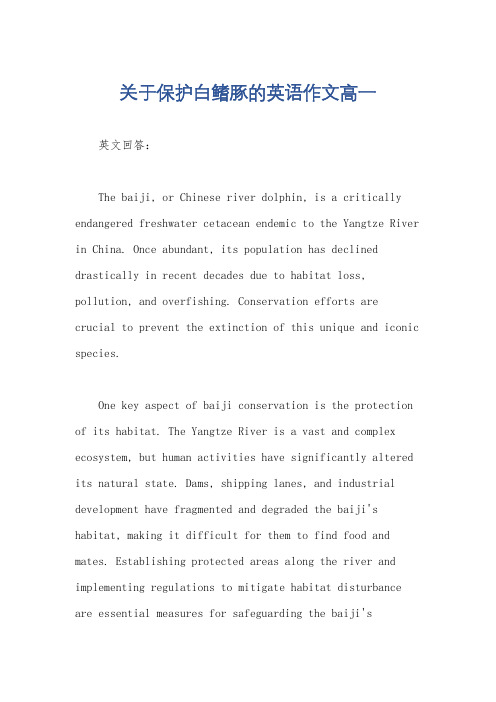
关于保护白鳍豚的英语作文高一英文回答:The baiji, or Chinese river dolphin, is a critically endangered freshwater cetacean endemic to the Yangtze River in China. Once abundant, its population has declined drastically in recent decades due to habitat loss, pollution, and overfishing. Conservation efforts arecrucial to prevent the extinction of this unique and iconic species.One key aspect of baiji conservation is the protection of its habitat. The Yangtze River is a vast and complex ecosystem, but human activities have significantly altered its natural state. Dams, shipping lanes, and industrial development have fragmented and degraded the baiji's habitat, making it difficult for them to find food and mates. Establishing protected areas along the river and implementing regulations to mitigate habitat disturbance are essential measures for safeguarding the baiji'ssurvival.Pollution is another major threat to the baiji. Industrial wastewater, agricultural runoff, and sewage discharge have contaminated the Yangtze River with a variety of pollutants, including heavy metals, pesticides, and plastics. These pollutants can accumulate in thebaiji's food chain and compromise their health and reproductive success. Reducing pollution sources and promoting sustainable water management practices are critical for the recovery of the baiji population.Overfishing has depleted the baiji's primary food source, which consists of various species of fish and shrimp. Overfishing not only reduces the availability of food for the baiji but also disrupts the entire food web. Bycatch, the accidental capture of non-target species in fishing gear, poses a particularly significant threat to the baiji. Implementing sustainable fishing practices and reducing bycatch are crucial steps towards ensuring a stable prey base for the baiji.In addition to addressing these threats, conservation efforts must also focus on research and monitoring. Understanding the baiji's biology, population dynamics, and habitat requirements is essential for developing effective conservation strategies. Regular surveys and monitoring programs provide valuable data on the baiji's abundance, distribution, and threats it faces. This information helps inform conservation decisions and track the progress of recovery efforts.Protecting the baiji is not only about saving an endangered species; it is also about protecting the health and well-being of the Yangtze River ecosystem. The baiji is a keystone species, playing a vital role in maintaining the balance of the river's ecosystem. Its conservation is crucial for the overall health of the river and the communities that depend on it.中文回答:白鳍豚,或称中华江豚,是一种极度濒危的淡水鲸类,是中国长江特有物种。
濒危动物白鳍豚英语作文
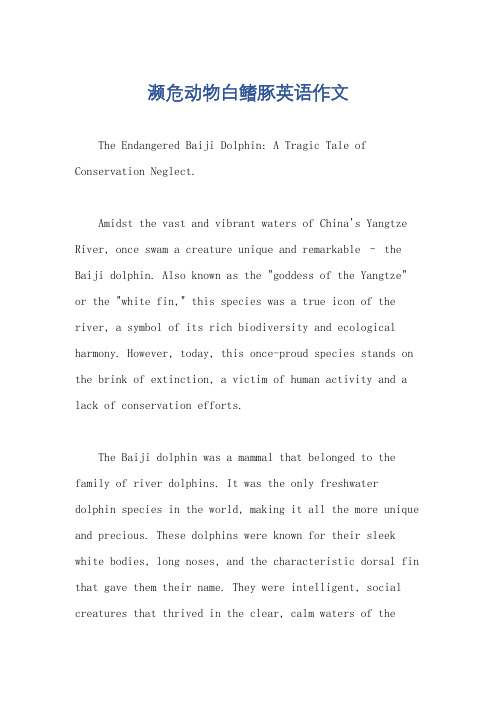
濒危动物白鳍豚英语作文The Endangered Baiji Dolphin: A Tragic Tale of Conservation Neglect.Amidst the vast and vibrant waters of China's Yangtze River, once swam a creature unique and remarkable – the Baiji dolphin. Also known as the "goddess of the Yangtze" or the "white fin," this species was a true icon of the river, a symbol of its rich biodiversity and ecological harmony. However, today, this once-proud species stands on the brink of extinction, a victim of human activity and a lack of conservation efforts.The Baiji dolphin was a mammal that belonged to the family of river dolphins. It was the only freshwater dolphin species in the world, making it all the more unique and precious. These dolphins were known for their sleek white bodies, long noses, and the characteristic dorsal fin that gave them their name. They were intelligent, social creatures that thrived in the clear, calm waters of theYangtze River.Unfortunately, the Baiji dolphin's existence was threatened by several factors. The rapid industrialization and urbanization of China, particularly along the Yangtze River, led to increased pollution and habitat degradation. The river's ecosystem was severely impacted by the discharge of sewage, industrial waste, and chemicals. This pollution not only poisoned the water but also destroyed the dolphin's food supply, making it difficult for them to survive.Another major threat to the Baiji dolphin was the increase in shipping traffic along the Yangtze River. As more and more boats and ships plied the river, they posed a significant risk to the dolphins. These vessels not only disturbed the dolphins' habitat but also caused numerous collisions and fatalities. The loud noises and vibrations from the ships' engines also disrupted the dolphins' communication and hunting abilities.Additionally, fishing activities along the river poseda threat to the dolphins. The use of harmful fishing methods like bottom trawling and gillnets not only decimated the dolphin's food supply but also entrapped and killed many dolphins incidentally. The loss of food sources and the constant danger from fishing gear made it increasingly difficult for the dolphins to survive.Unfortunately, despite these threats, conservation efforts for the Baiji dolphin were woefully inadequate. There was a lack of awareness and understanding about the species' plight among the general population. The Chinese government and conservation organizations also failed to take sufficient measures to protect the dolphins. There were no specific laws or policies to safeguard the species, and the few conservation programs that existed were underfunded and inadequately implemented.The Baiji dolphin's decline was a slow and tragic one. Over the years, their numbers dwindled as the threats to their survival mounted. By the early 2000s, it was estimated that there were only a few dozen Baiji dolphins left in the Yangtze River. In 2006, after a decade-longsearch, scientists declared the species functionally extinct, meaning that there were no longer enough individuals to maintain a viable population.The loss of the Baiji dolphin is a tragic reminder of the impact of human activity on the natural world. It's a sobering tale of how neglect and indifference can lead to the extinction of even the most unique and remarkable species. The Baiji dolphin's demise should serve as a wake-up call for us all, urging us to take action and conserve our planet's biodiversity.While the Baiji dolphin may be gone, it's not too late to learn from its tragic fate. We must prioritize conservation efforts and take urgent action to protect the remaining freshwater dolphin species and other threatened animals. We need to reduce pollution, regulate shipping traffic, and adopt sustainable fishing practices. We also need to raise awareness and educate the public about the importance of biodiversity conservation.In conclusion, the loss of the Baiji dolphin is adevastating reminder of the fragility of our planet's ecosystems. It's a call to action for all of us to take responsibility for conserving our natural world and ensuring a sustainable future for all species. Let's learn from the Baiji dolphin's tragic tale and work together to protect the biodiversity of our planet.。
目前对白鳍豚的保护英语作文
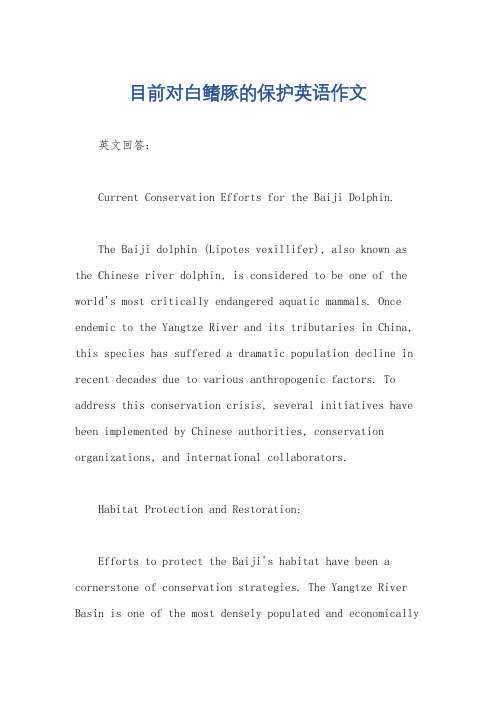
目前对白鳍豚的保护英语作文英文回答:Current Conservation Efforts for the Baiji Dolphin.The Baiji dolphin (Lipotes vexillifer), also known as the Chinese river dolphin, is considered to be one of the world's most critically endangered aquatic mammals. Once endemic to the Yangtze River and its tributaries in China, this species has suffered a dramatic population decline in recent decades due to various anthropogenic factors. To address this conservation crisis, several initiatives have been implemented by Chinese authorities, conservation organizations, and international collaborators.Habitat Protection and Restoration:Efforts to protect the Baiji's habitat have been a cornerstone of conservation strategies. The Yangtze River Basin is one of the most densely populated and economicallydeveloped areas in the world, posing significant threats to the dolphin's environment. Recognizing the need to mitigate these impacts, the Chinese government has established a number of nature reserves and protected areas along the river. These areas aim to safeguard the dolphin's habitat from further degradation, reduce pollution, and control fishing activities.Captive Breeding Programs:In 1996, the Chinese government launched a captive breeding program for the Baiji. The goal of this program was to establish a genetically viable population in captivity, potentially providing a source of individualsfor reintroduction efforts in the future. However, the program has faced challenges, including the difficulty of breeding the dolphins in captivity and the high mortality rate of calves. As of 2018, no Baiji dolphins remain in captivity.Scientific Research and Monitoring:To inform conservation efforts, researchers have conducted extensive studies on the Baiji's biology, ecology, and behavior. This research has helped to identify the threats facing the species and has provided insights into potential conservation measures. Regular monitoring surveys are conducted along the Yangtze River to track population trends and assess the effectiveness of conservation interventions.Public Education and Awareness:Raising public awareness about the plight of the Baiji has been crucial for mobilizing support for conservation efforts. Educational campaigns have been launched to inform local communities and the general public about the importance of the Baiji and the conservation challenges it faces. By engaging with local populations, conservationists hope to foster a sense of stewardship and encourage responsible behavior towards the species.Despite these conservation efforts, the Baijipopulation continues to decline. The species has becomenotoriously difficult to find in the wild, and fears are growing that it may soon be extinct. Time is running outfor the Baiji, and urgent action is needed to save this iconic and irreplaceable species.中文回答:白鳍豚保护现状。
白鳍豚介绍英文介绍作文
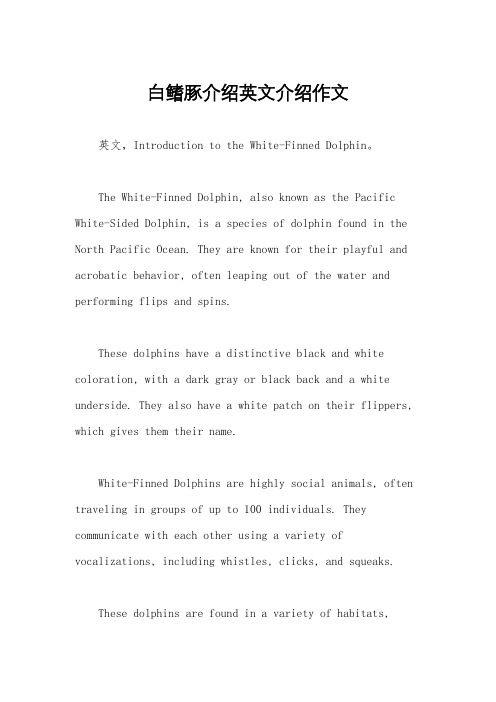
白鳍豚介绍英文介绍作文英文,Introduction to the White-Finned Dolphin。
The White-Finned Dolphin, also known as the Pacific White-Sided Dolphin, is a species of dolphin found in the North Pacific Ocean. They are known for their playful and acrobatic behavior, often leaping out of the water and performing flips and spins.These dolphins have a distinctive black and white coloration, with a dark gray or black back and a white underside. They also have a white patch on their flippers, which gives them their name.White-Finned Dolphins are highly social animals, often traveling in groups of up to 100 individuals. They communicate with each other using a variety of vocalizations, including whistles, clicks, and squeaks.These dolphins are found in a variety of habitats,including coastal waters, offshore waters, and even in some freshwater rivers. They feed on a variety of fish and squid, using echolocation to locate their prey.Overall, the White-Finned Dolphin is a fascinating and charismatic species, beloved by many for their playful behavior and striking appearance.中文,白鳍豚介绍。
濒危动物白鳍豚英语作文
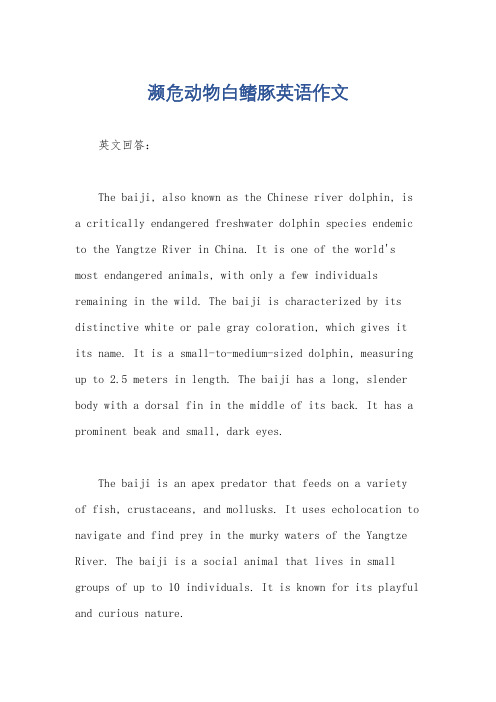
濒危动物白鳍豚英语作文英文回答:The baiji, also known as the Chinese river dolphin, is a critically endangered freshwater dolphin species endemic to the Yangtze River in China. It is one of the world's most endangered animals, with only a few individuals remaining in the wild. The baiji is characterized by its distinctive white or pale gray coloration, which gives it its name. It is a small-to-medium-sized dolphin, measuring up to 2.5 meters in length. The baiji has a long, slender body with a dorsal fin in the middle of its back. It has a prominent beak and small, dark eyes.The baiji is an apex predator that feeds on a variety of fish, crustaceans, and mollusks. It uses echolocation to navigate and find prey in the murky waters of the Yangtze River. The baiji is a social animal that lives in small groups of up to 10 individuals. It is known for its playful and curious nature.The baiji is facing a number of threats, including habitat loss, pollution, and overfishing. The constructionof dams and other water infrastructure projects has fragmented the Yangtze River and destroyed much of thebaiji's habitat. Pollution from industrial and agricultural sources has also degraded the water quality in the river, making it difficult for the baiji to survive. Overfishing has reduced the availability of food for the baiji, makingit even more vulnerable to extinction.Conservation efforts are underway to protect the baiji, including the establishment of nature reserves and the implementation of fishing bans. However, the baiji's population continues to decline, and it is now considered one of the most endangered animals in the world.中文回答:白鳍豚,也称中华江豚,是一种极度濒危的淡水豚类,是长江流域特有的物种。
白鳍豚英文小作文
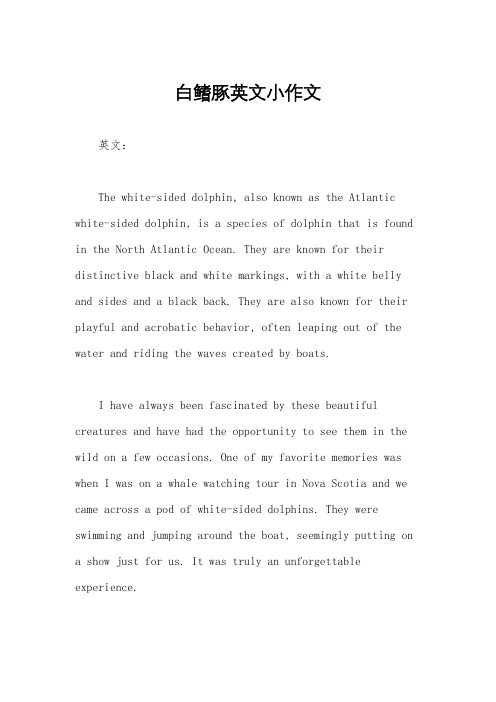
白鳍豚英文小作文英文:The white-sided dolphin, also known as the Atlantic white-sided dolphin, is a species of dolphin that is found in the North Atlantic Ocean. They are known for their distinctive black and white markings, with a white belly and sides and a black back. They are also known for their playful and acrobatic behavior, often leaping out of the water and riding the waves created by boats.I have always been fascinated by these beautiful creatures and have had the opportunity to see them in the wild on a few occasions. One of my favorite memories was when I was on a whale watching tour in Nova Scotia and we came across a pod of white-sided dolphins. They were swimming and jumping around the boat, seemingly putting on a show just for us. It was truly an unforgettable experience.中文:白鳍豚,也被称为大西洋白鳍豚,是一种生活在北大西洋海洋的海豚。
高一保护白鳍豚作文英语
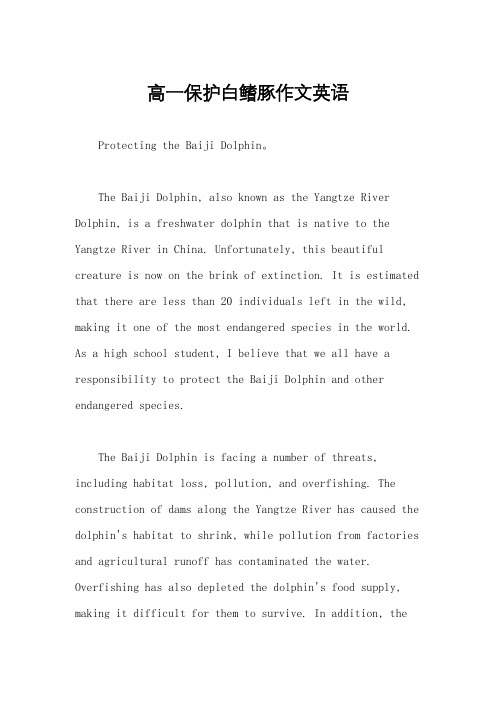
高一保护白鳍豚作文英语Protecting the Baiji Dolphin。
The Baiji Dolphin, also known as the Yangtze River Dolphin, is a freshwater dolphin that is native to the Yangtze River in China. Unfortunately, this beautiful creature is now on the brink of extinction. It is estimated that there are less than 20 individuals left in the wild, making it one of the most endangered species in the world. As a high school student, I believe that we all have a responsibility to protect the Baiji Dolphin and other endangered species.The Baiji Dolphin is facing a number of threats, including habitat loss, pollution, and overfishing. The construction of dams along the Yangtze River has caused the dolphin's habitat to shrink, while pollution from factories and agricultural runoff has contaminated the water. Overfishing has also depleted the dolphin's food supply, making it difficult for them to survive. In addition, theBaiji Dolphin is often accidentally caught in fishing nets, which can lead to injury or death.To protect the Baiji Dolphin, we need to take action on several fronts. First, we need to raise awareness about the plight of this endangered species. Many people in China are not aware of the Baiji Dolphin and its importance to the ecosystem. By educating the public, we can build supportfor conservation efforts and encourage people to take action.Second, we need to take steps to reduce pollution in the Yangtze River. This can be done by regulating factories and agricultural practices, as well as improving wastewater treatment facilities. By reducing pollution, we can help to restore the dolphin's habitat and improve the overall health of the river.Third, we need to address the issue of overfishing. This can be done by implementing fishing quotas and regulations, as well as promoting sustainable fishing practices. By ensuring that there is enough food for theBaiji Dolphin, we can help to ensure their survival.Finally, we need to take steps to reduce accidental bycatch of the Baiji Dolphin. This can be done by promoting the use of dolphin-friendly fishing gear, such as nets with escape panels. By reducing accidental bycatch, we can help to protect the dolphin from injury or death.In conclusion, the Baiji Dolphin is a critically endangered species that requires our attention and protection. By raising awareness, reducing pollution, addressing overfishing, and reducing accidental bycatch, we can help to ensure the survival of this beautiful and important animal. As high school students, we can make a difference by taking action and advocating for the protection of the Baiji Dolphin and other endangered species.。
白鳍豚用英文介绍作文
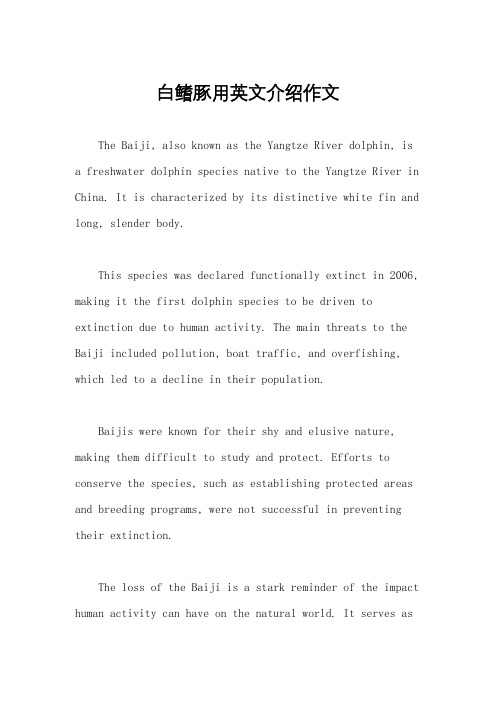
白鳍豚用英文介绍作文The Baiji, also known as the Yangtze River dolphin, is a freshwater dolphin species native to the Yangtze River in China. It is characterized by its distinctive white fin and long, slender body.This species was declared functionally extinct in 2006, making it the first dolphin species to be driven to extinction due to human activity. The main threats to the Baiji included pollution, boat traffic, and overfishing, which led to a decline in their population.Baijis were known for their shy and elusive nature, making them difficult to study and protect. Efforts to conserve the species, such as establishing protected areas and breeding programs, were not successful in preventing their extinction.The loss of the Baiji is a stark reminder of the impact human activity can have on the natural world. It serves asa call to action for the conservation of other endangered species and the preservation of their habitats.Despite the extinction of the Baiji, there is still hope for other endangered species. Conservation efforts and public awareness can make a difference in protecting the biodiversity of our planet. It is up to us to take action and ensure that other species do not suffer the same fate as the Baiji.。
